How to Build Agentic AI Workflows for Enterprises
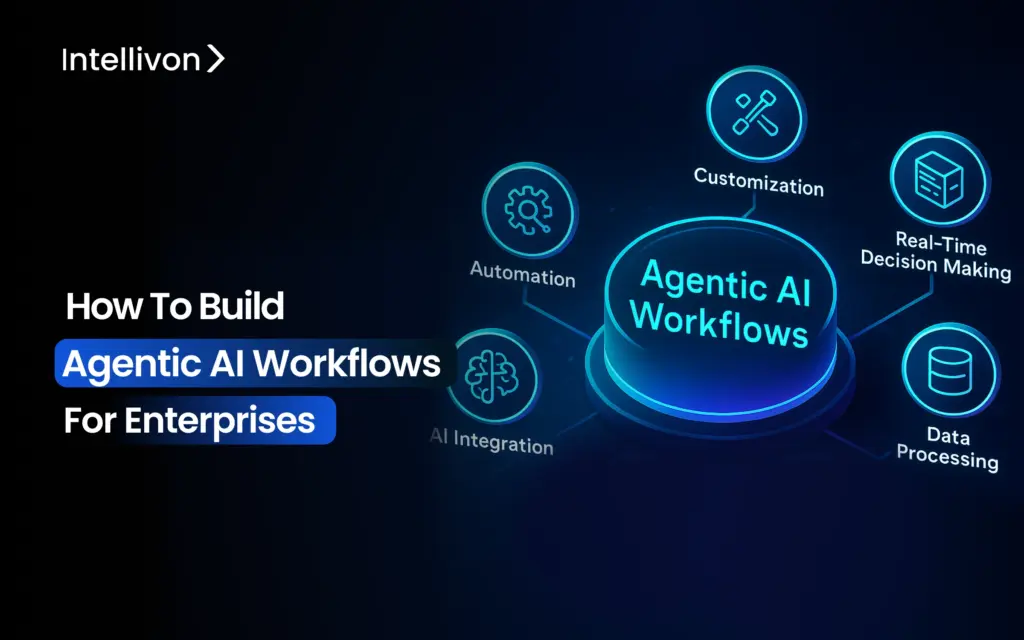
In the current AI-dominated landscape, traditional AI systems still struggle with the dynamic decision-making required to stay competitive. Enterprises with vast proprietary data and complex, intricate workflows need systems that can automate processes, and at the same time think, learn, and adapt on their own. That’s where agentic AI workflows come in. These intelligent systems transform your business by handling complex, end-to-end processes with remarkable autonomy and precision. Enterprises that have adopted agentic AI workflows will be able to tackle new situations, learn from data, and make decisions with far more speed and accuracy. PayPal uses agentic AI in its workflows and, as a result, has automated 90% of individual automobile claims in large-scale insurance use cases. We have helped large enterprises successfully integrate agentic AI workflows into their operations, streamlining repetitive tasks and handling complex issues. This has helped their teams focus on strategic work while the AI agents that we built took care of the grunt work. In this blog, we will show you how we built these systems and tailored them to enterprise-specific requirements, driving efficient workflows and higher ROIs. Key Insights of the Enterprise AI Agent Market The global enterprise agentic AI market was valued at USD 2.58 billion in 2024 and is projected to grow to USD 24.50 billion by 2030, with a CAGR of 46.2% from 2025 to 2030, according to a Grand View Research report. Key drivers of this growth include the increasing complexity of business environments and the need for faster decision-making. Credit: Grand View Research Key Market Trends & Insights: North America led the global enterprise agentic AI market in 2024, accounting for over 39% of the market share. The U.S. is expected to show significant growth in the agentic AI market over the forecast period. Machine learning was the leading technology segment in 2024, holding 29% of the global market revenue share. The single-agent systems segment dominated in 2024 due to their simplicity and cost-effectiveness in automating specific tasks. By 2025, it’s expected that over 60% of repetitive workflows in major enterprises will be managed by AI agents. Why Enterprises Need Agentic AI Now In today’s fast-paced business world, enterprises face growing pressure to stay competitive, drive innovation, and reduce costs. Traditional methods of automation are no longer enough to meet these demands. This is where agentic AI comes into play, offering a new level of autonomy and precision in managing workflows. 1. Increased Complexity in Operations Business environments are more complex than ever. Companies juggle multiple tasks, data sources, and customer expectations, all while trying to make quick, informed decisions. Agentic AI steps in to automate these complex processes. Unlike traditional automation, which follows rigid rules, agentic AI can adapt to new information, learn from experience, and make decisions on its own. Take IBM Watson Health as an example. In healthcare, the AI system processes and analyzes vast amounts of medical data to recommend personalized treatment plans for patients. This reduces the time doctors spend on administrative tasks, allowing them to focus more on patient care. The ability of AI to make intelligent decisions and adapt to new data makes it an invaluable tool for businesses dealing with increasing complexity. 2. Speedy Decision-Making In industries like finance, healthcare, and logistics, even a small delay in decision-making can have significant consequences. In supply chain management, for instance, AI agents can predict disruptions before they happen and take action. Gartner reports that companies using AI-powered supply chains experience 50% faster decision-making and 30% cost reduction. This efficiency would be impossible with traditional, manual workflows. Similarly, in retail, companies like Walmart and Amazon are using AI to optimize their inventory management. AI systems predict demand patterns, manage stock levels, and even reorder products automatically. This not only reduces waste but also ensures that customers always find the products they need when they need them. AI-driven decision-making allows these businesses to move quickly, responding to demand fluctuations without human intervention. 3. Scalability and Adaptability As enterprises grow, their processes must scale seamlessly. Agentic AI allows businesses to automate more tasks without the need for a proportional increase in human resources. This scalability is especially evident in customer service. AI-powered systems, such as chatbots and virtual assistants, can handle thousands of customer inquiries simultaneously, providing 24/7 support. This scalability helps businesses meet rising demand without compromising quality. 4. Future-Proof Solution The evolution of AI technology means that agentic AI workflows will only become more sophisticated. They’ll be capable of handling increasingly complex decision-making and automating entire enterprise processes. By embracing agentic AI now, businesses can optimize their operations today while future-proofing themselves for tomorrow’s challenges. The ability to adapt, scale, and make decisions faster than ever will be a defining feature of successful enterprises in the years to come. How Agentic AI Works in Enterprise Workflows Agentic AI workflows are much more than simple automations. Imagine an employee who not only follows instructions but also understands the bigger picture, makes smart decisions, and improves over time. That’s how agentic AI works. It’s a system that learns and adapts, making it incredibly valuable for enterprises that want to move beyond basic task automation. Here’s a breakdown of how it works: 1. Perception and Context Awareness The first step in an agentic AI workflow is “perception.” This means the system collects and processes data from multiple sources. Think of it like a customer service bot reading customer emails, a supply chain agent monitoring inventory levels, or a financial agent tracking market trends. But the AI understands the context after collecting the data. For example, it knows whether its goal is to resolve customer issues quickly or optimize inventory costs. By understanding the goal, the AI prioritizes the data it collects and makes
Why CIOs Must Prioritize AI Governance for Enterprises
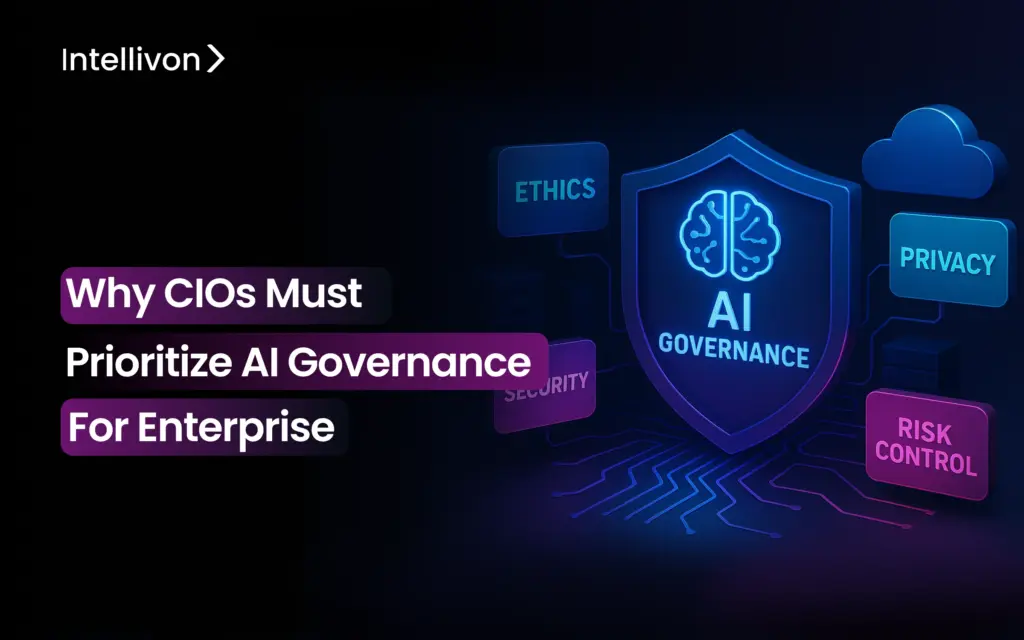
AI adoption across enterprises is skyrocketing, but so are the potential risks, and that is why CIOs can no longer afford to overlook AI governance. This urgency has overspilled the need for compliance and has spread to the importance of safeguarding the future of businesses. The need for clear governance frameworks is no longer optional. It’s essential to ensure AI is used responsibly, transparently, and ethically within your organization. Unregulated AI systems can lead to data breaches, biased decisions, and even violations of privacy laws. Robust and scalable AI-powered governance frameworks customized to enterprise needs are essential to ensure scalability without compromising security. We have partnered with global companies that were facing frequent data breaches and built them customized, stable, and scalable AI governance frameworks. These have resulted in forward-thinking enterprises that earn higher ROI and strive for growth without the burden of security weighing on them. This blog will explore why AI governance should be a top priority for CIOs and how Intellivon can help build customized enterprise-grade AI governance frameworks for enterprises. What is AI Governance and Why Are Enterprises Adopting It? AI governance is a set of rules and systems that guide how companies use AI. It includes frameworks, policies, and oversight to make sure AI is used in a safe and responsible way. This means setting ethical standards, following laws, and managing risks. AI governance covers every stage of AI, from design to launch and beyond. It ensures that AI tools are trained, tested, used, and improved in line with company values and legal requirements. In short, robust AI governance helps organizations use AI to its full potential for necessary business operations while avoiding harm. Key Takeaways of the AI Governance Market The global AI governance market is expected to grow rapidly, from $309 million in 2025 to about $4.83 billion by 2034, at a CAGR of 35.7%, according to Precedence Research. Large companies, mainly in finance, healthcare, and tech, make up about 70% of the market because they face more complex regulations. Credit: Precedence Research North America leads with 31% of the market in 2024, thanks to strong regulations and digital infrastructure. Big companies in finance, healthcare, and defense hold about 70% of the market. Market growth is driven by more global AI use and new regulations to manage risks like bias, privacy, and security. Why AI Governance is an Enterprise Imperative As AI continues to reshape the way businesses operate, it’s crucial for CIOs to prioritize AI governance. Without proper governance, AI systems can introduce serious risks, from unethical decision-making to regulatory non-compliance. In this rapidly evolving landscape, having a robust governance framework is essential for safeguarding your business and its future. 1. Ensuring Compliance AI governance is essential for staying compliant with increasingly complex regulations. Laws like GDPR require enterprises to ensure their AI systems handle personal data securely and transparently. Non-compliance can lead to hefty fines and significant reputational damage. By implementing proper governance, companies can avoid legal complications and ensure they meet data privacy standards. 2. Mitigating Risks in AI Systems AI systems can present various risks, including data breaches and bias in decision-making. Without governance, these risks escalate quickly, exposing businesses to security threats or ethical violations. AI governance ensures that systems are secure, data is handled responsibly, and decisions are free from bias, ultimately protecting the company from costly errors. 3. Building Trust with Stakeholders Adopting strong AI governance builds trust with customers, investors, and partners. Transparency in how AI systems operate and make decisions fosters confidence in the business. When stakeholders see that an enterprise is committed to ethical and responsible AI use, they are more likely to support it, creating stronger business relationships. 4. Gaining a Competitive Advantage Enterprises that implement effective AI governance are seen as leaders in their industries. By ensuring their AI systems are ethical, compliant, and transparent, these businesses differentiate themselves from competitors. Strong governance not only protects the company but also attracts customers, partners, and investors who value ethical AI practices. 5. Long-Term Business Sustainability AI governance is key to long-term business success. By proactively managing AI systems, companies can avoid future risks and adapt to changing regulations. This ensures that AI systems remain compliant and relevant, enabling businesses to scale their AI initiatives with confidence and secure long-term growth. Key Challenges Enterprise CIOs Face in AI Governance Implementing AI governance is essential, but it’s not without its challenges. For CIOs in large enterprises, managing AI systems effectively requires navigating complex issues like expertise gaps, resource allocation, and the evolving nature of AI technology. Understanding these challenges is crucial to developing a governance framework that protects the business and ensures AI operates responsibly. 1. Lack of Skilled Expertise One of the biggest hurdles in AI governance is the lack of skilled experts. AI technology is highly specialized, and understanding its complexities requires a deep understanding of both technical and ethical considerations. Many organizations struggle to find or train professionals who can effectively manage AI systems while ensuring compliance and ethical standards. As AI continues to evolve, this skills gap becomes more pronounced, making it harder for enterprises to stay ahead of potential governance risks. 2. Complexity of AI Systems AI systems are often highly complex, with numerous algorithms, data sources, and outcomes to manage. This complexity makes it difficult to monitor and govern AI effectively. It’s not just about ensuring that AI models are working properly; it’s about making sure they remain ethical, transparent, and fair across all their applications. For CIOs, creating a framework that manages this complexity and provides clear oversight across different departments and AI use cases is a significant challenge. 3. Resource Allocation and Budgeting Building a comprehensive AI governance framework requires both financial investment
Why Enterprises Need Private AI Systems
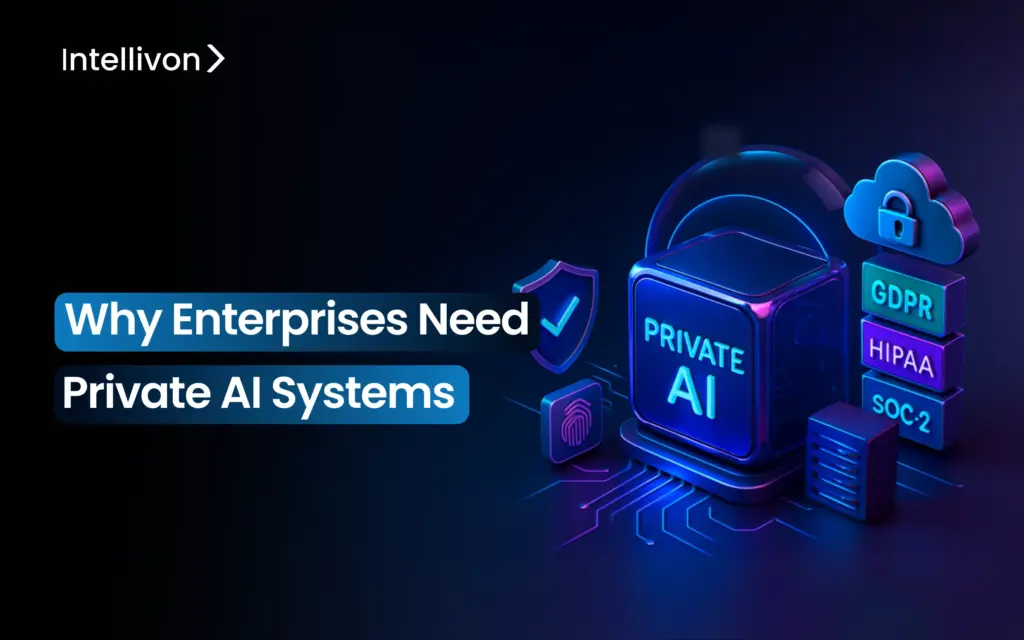
What if your enterprise’s confidential data became the training data for your competitor’s AI? This is a very real risk in today’s business world. As AI grows more powerful, competitors can gain access to your data and quickly launch products or solutions based on it. The speed at which AI can process and learn from data means that the advantage you once had can vanish in the blink of an eye. About one-third (32%) of cyber incidents in 2024 involved data theft and leaks, solidifying the need for systems that can help you scale AI, yet keep it private and compliant. Public AI solutions often put businesses at risk. They can expose sensitive information and make compliance harder. This is why enterprises need private AI systems that offer more control over their data. Around 60-70% of enterprises are now using or building private AI systems to ensure data privacy and maintain a competitive edge. Intellivon specializes in designing scalable private AI systems for large enterprises, keeping security and compliance at its core. Our AI experts leverage our suite of cutting-edge tools dedicated to crafting 100% compliant and secure AI systems. We build and implement private AI systems specifically customized to fit your unique enterprise needs. Our solutions give you full control over your data while ensuring security, privacy, and compliance. In this blog, we walk you through why your enterprise needs these private AI systems and how we develop them from the ground up. What is Private AI and Why Enterprises Need It The global generative AI market was worth $25.86 billion in 2024 and is expected to grow to $1005.07 billion by 2034, with an annual growth rate of 44.20% from 2025 to 2034, according to Precedence Research. Around 60-70% of businesses are adopting or building private AI systems to have better control over data privacy and security, and to stay competitive. Many companies are investing heavily in AI, with 88% of mid-to-large organizations spending more than 5% of their IT budgets on AI, particularly on private AI. North America is leading in private AI investments, with over $109 billion spent on private AI in 2024 alone. What is Private AI? Private AI refers to artificial intelligence systems that are designed and deployed within a private, secure environment, specifically for a single organization. Unlike public AI, which relies on cloud services and shared data, private AI ensures that the enterprise retains full control over its data. This means that sensitive business data never leaves the company’s secure infrastructure, minimizing risks associated with data exposure, security breaches, or misuse. Private AI systems are custom-built to meet the specific needs of an enterprise. They can be tailored to work with the company’s existing infrastructure and data while providing the necessary level of security. This makes private AI a preferred choice for large organizations that deal with sensitive customer information, intellectual property, and proprietary business algorithms. Private vs Public AI – Which is Better For Enterprises When choosing an AI solution for your enterprise, it’s crucial to decide whether a private or public AI system is the best fit for your needs. While both have their advantages, understanding the key differences can help you make a more informed decision. Private AI gives enterprises full control over their data, security, and AI models. It operates within the company’s secure infrastructure, ensuring that sensitive information stays protected. This level of control is especially important for businesses that handle proprietary data or must comply with strict data protection regulations. Public AI, on the other hand, is hosted on third-party cloud services and often involves shared infrastructure. It offers convenience, cost-effectiveness, and scalability, but can expose enterprises to security risks and potential data misuse. Public AI is generally easier to implement but may not offer the level of customization or security that large organizations require. Key Differences Between Private AI and Public AI Feature Private AI Public AI Data Security Full control over data, ensuring privacy and protection Data may be stored and processed off-site, exposing it to security risks Compliance Easier to comply with strict regulations (GDPR, CCPA, etc.) Compliance can be more difficult due to reliance on third-party services Customization Highly customizable to business needs Limited customization options Cost Higher upfront cost for infrastructure and maintenance Generally more affordable, with pay-as-you-go pricing models Scalability Scalable, but may require more resources to grow Easily scalable due to cloud-based infrastructure Implementation Time Longer implementation, requiring more setup Faster implementation with ready-to-use solutions In summary, private AI is often the better choice for enterprises that require complete control over their data, need to comply with regulations, or work with sensitive information. Benefits of Private AI Systems for Large Enterprises Private AI systems provide large enterprises with essential advantages, including enhanced security, full data control, tailored solutions, and scalability. These benefits help businesses protect sensitive information and drive operational efficiency. 1. Data Privacy and Security Private AI ensures that sensitive data, such as customer information or proprietary algorithms, stays within the organization’s controlled environment. By eliminating reliance on third-party cloud services, private AI reduces the risk of data leaks or breaches. 2. Compliance with Regulations With growing concerns about data privacy, adhering to regulations is crucial. Private AI allows enterprises to fully control how data is stored, processed, and used, ensuring compliance with strict data protection laws. 3. Competitive Advantage When data is securely housed within a private AI system, an enterprise can maintain a competitive edge by leveraging its unique data without risking exposure to competitors. Public AI solutions often use data from multiple sources, potentially giving competitors insights into an enterprise’s proprietary data. 4. Customization and Scalability Private AI solutions can be tailored to an enterprise’s specific needs. Whether it’s adjusting AI models for unique business goals or scaling AI systems as the business grows, private AI systems provide the flexibility needed for long-term success. By adopting private AI, enterprises can ensure their data is secure, their operations are compliant, and they can maintain their
Custom AI Chatbots VS Pre-Made Chatbots for Enterprise
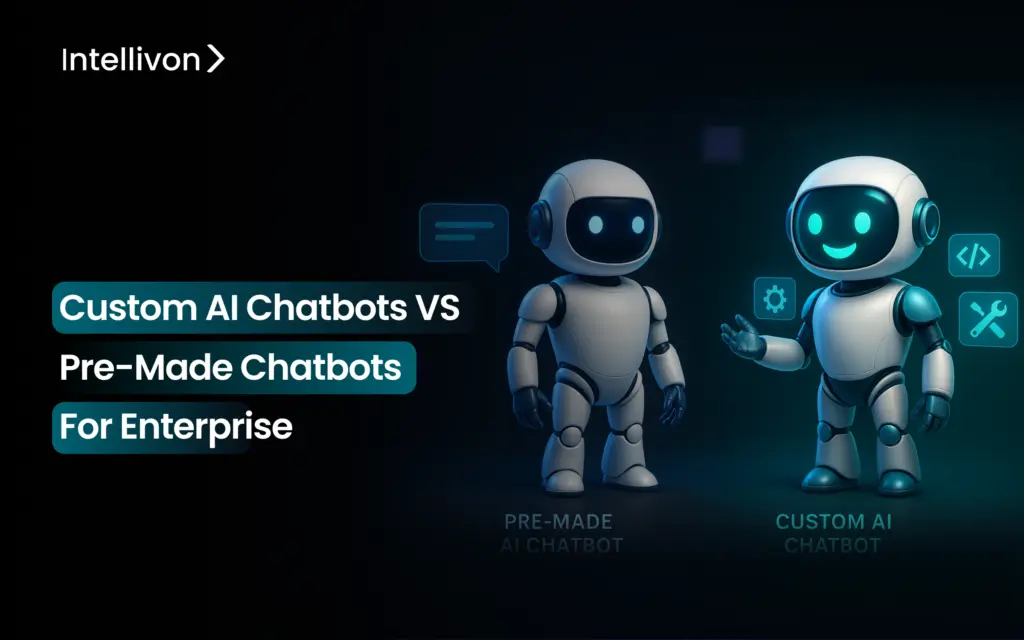
As businesses grow and customer expectations rise, AI chatbots are becoming a must-have tool for improving efficiency and customer service. In fact, 80% of businesses plan to implement or expand their chatbot use by this year to boost engagement and ROI. But with so many options available, businesses face a dilemma: should they go with a pre-built chatbot or invest in a custom solution? While pre-built bots offer quick setup and cost efficiency, they often fall short when handling complex tasks and integrating with existing systems. The key is choosing a solution that scales with your business needs over time. We’ve helped several enterprises build custom AI chatbot solutions that streamline workflows, enhance customer service, and drive efficiency. Intellivon’s expertise in developing AI-powered chatbots ensures that businesses can automate complex tasks, provide personalized customer experiences, and seamlessly integrate with existing systems. Our solutions not only improve customer engagement but also scale with your business as it grows. That’s why we’ve created this blog, to guide you to choose the right chatbot and help build a custom AI chatbot tailored to your enterprise’s unique needs, ensuring long-term success and operational excellence. Key Market Takeaways of Enterprise AI Chatbots According to a Grand View Research report, the global chatbot market size was valued at USD 7.76 billion in 2024 and is projected to reach USD 27.29 billion by 2030, growing at a CAGR of 23.3% from 2025 to 2030. A key driver in this market is the surge of AI and machine learning trends. Key Market Takeaways: 88% of people had at least one conversation with a chatbot in the past year. 87% rate their chatbot interactions as neutral or positive. 62% would rather use a chatbot than wait for a human agent. 59% expect a chatbot reply within 5 seconds. 74% prefer chatbots for getting quick, simple answers. 80% of financial institutions see chatbots as a major opportunity. Healthcare: 68% of healthcare organizations now use AI chatbots. Global customer service cost savings: $11 billion annually by 2025 after using AI Chatbots. Average annual savings per company after using AI Chatbots: $300,000. Routine questions handled without humans: Up to 80%. By 2027, 25% of businesses will use chatbots as their main customer service tool. As enterprises continue to embrace digital transformation, chatbots have become an essential tool for managing customer interactions at scale. However, as the market expands, businesses must consider their unique needs to choose the right chatbot solution, whether pre-built or custom, to ensure long-term success and scalability. The Role of AI Chatbots in Enterprise Growth AI chatbots play a multifaceted and crucial role in the growth of large enterprises. They have evolved into strategic assets that help businesses drive efficiency, strengthen customer relationships, and gather valuable business insights. Here are at least five key roles AI chatbots play in the growth of enterprises: 1. Improving Customer Service and Engagement AI chatbots bring a fundamental shift in how enterprises handle customer service. According to a Zendesk report, 69% of customers prefer self-service over speaking with an agent, and chatbots can deliver just that by offering 24/7 availability. This ensures customers receive instant support and answers to common questions at any time, from anywhere. The immediate, round-the-clock access to assistance eliminates long wait times, offering a consistent, reliable point of contact. By handling high volumes of routine inquiries, chatbots free up human agents to focus on more complex and high-value customer issues, ultimately improving service quality and increasing overall customer satisfaction. This shift not only enhances customer experience but also boosts brand loyalty. 2. Boosting Sales and Lead Generation AI chatbots are a powerful tool for driving sales and enhancing lead generation. According to Statista, chatbots are expected to generate $142 billion in cost savings by 2024 across various industries, including sales and marketing. Chatbots can engage proactively with website visitors, answer product-related questions, and offer personalized recommendations based on browsing history. More importantly, they play a critical role in qualifying leads by asking targeted questions to assess potential customers’ needs before seamlessly passing them off to human sales representatives. This automation shortens the sales cycle, improves lead conversion rates, and ultimately contributes to higher revenue. 3. Enhancing Operational Efficiency For large enterprises, maintaining operational efficiency is crucial to staying ahead in a competitive market. AI chatbots can streamline many internal processes by providing employees with quick and easy access to information. For instance, in HR departments, chatbots can answer frequently asked questions about company policies, benefits, or leave requests, while in IT departments, they can assist with password resets or troubleshoot technical issues. By automating these tasks, chatbots reduce the workload on internal support teams, leading to higher productivity and faster decision-making. According to a PwC survey, 34% of businesses have already seen improved operational efficiency by integrating AI chatbots into their workflows. 4. Gathering Valuable Business Insights Every interaction an AI chatbot has is a potential source of data that can help shape business strategies. AI chatbots are designed to collect and analyze conversational data, offering enterprises valuable insights into customer behavior, pain points, feedback, and emerging trends. For example, Customer Support chatbots can track recurring issues, while Sales chatbots gather insights into what customers are asking or interested in. Analyzing sentiment and content helps businesses fine-tune products, marketing strategies, and operational processes. 5. Reducing Operational Costs The adoption of AI chatbots can significantly reduce operational costs for large enterprises. By automating routine tasks in customer service, HR, and IT support, businesses can cut down on the need for extensive human resources in these areas. This is especially important for providing 24/7 support, which would otherwise require expensive after-hours staffing. The cost savings from reduced labor needs, combined with improved productivity, lead to a strong return on investment (ROI). According to a Juniper Research study, chatbots are expected to reduce business costs by over $8 billion annually by 2022 through the automation of customer service tasks alone. These key roles show how AI chatbots are transforming enterprises by
Top Enterprise AI Trends in 2025
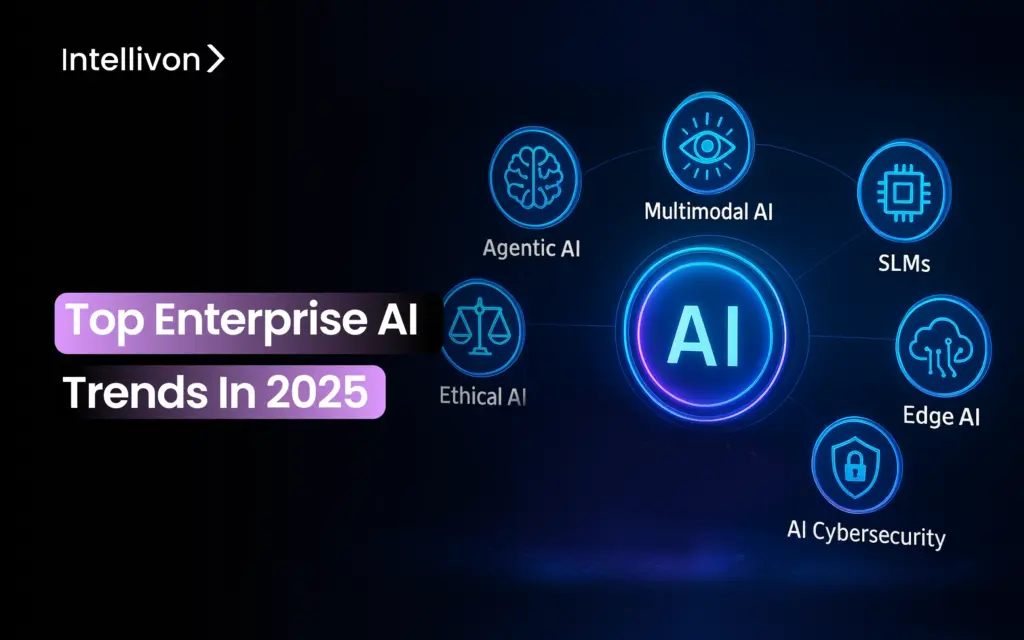
In the current context, AI has moved beyond automating mundane tasks to include influence over the way enterprises think, decide, and compete. The most advanced organizations are moving past surface-level automation into intelligent systems that learn, adapt, and act with precision. This evolution is shifting workflows from reactive problem-solving to proactive strategy-making, giving leaders the power to anticipate opportunities and risks before they appear. For enterprise decision-makers, that means fewer blind spots, faster pivots, and strategies that outpace the market. Those who embed AI into the very fabric of their operations today will define the competitive benchmarks of tomorrow. With AI adoption accelerating across data-driven industries, the urgency for quick, seamless, and scalable integration has never been higher. At Intellivon, we help enterprises design, build, and integrate AI solutions that align with their strategic goals from day one. In this blog, we’ll unpack the top Enterprise AI trends of 2025 and share how we can help you bring them to life in your workflows, effectively, securely, and at scale. Key Market Takeaways for AI in Enterprise Operations The enterprise AI market is expected to grow from USD 97.2 billion in 2025 to USD 229.3 billion by 2030, with an annual growth rate of 18.9%, according to a Mordor Intelligence report. The fuel behind this growth is attributed to the rapid adoption of generative AI, agentic systems that automate complex tasks, and increasing demand for specialized silicon to reduce inference times. By 2025, more than 78% of companies are expected to use AI in various areas like customer experience, operations, finance, and HR. AI is becoming a key feature in enterprise SaaS products, with over 60% of them expected to include AI capabilities by 2025. The growing need for automation, AI-driven solutions, and the ability to process large enterprise data are major factors fueling this growth. Specialized hardware for AI, such as GPUs and TPUs, is also seeing rapid growth, with demand for AI chips expected to grow at over 23% annually. Hybrid and edge AI models are outpacing traditional public cloud deployments, as businesses prioritize lower latency and data sovereignty. Healthcare is leading AI investment, with a projected annual growth rate of 22.17%. AI is predicted to significantly boost global economic growth, with some estimates suggesting it could add more than $15 trillion in revenue by 2030 across various sectors. Role of AI in Revolutionizing Enterprise Operations AI has already become a core operational engine for enterprises across industries. It is transforming processes with unmatched efficiency, agility, and innovation. Here are some ways in which AI transforms enterprise operations. 1. Streamlining Operations Through Automation AI-powered automation now handles both routine and complex workflows with minimal human input. From inventory management and compliance monitoring to customer service, AI systems process large datasets in real time, flagging issues instantly and making proactive adjustments. This reduces manual work, cuts errors, and speeds up delivery. For example, leading retailers use AI to predict demand, optimize supply chains, and reduce costs, all while ensuring faster, more accurate deliveries. The result is smoother operations that scale without adding overhead. 2. Driving Data-Driven Decision-Making Enterprises are harnessing AI analytics to turn vast amounts of structured and unstructured data into actionable insights. Predictive models powered by machine learning forecast market shifts, guide resource allocation, and refine product design. These insights allow leaders to make faster, smarter decisions, keeping strategies aligned with real-time market intelligence. This agility translates directly into competitive advantage. 3. Enhancing Customer Experience and Personalization AI is elevating customer service from reactive support to proactive engagement. AI chatbots and virtual assistants handle large volumes of queries instantly, providing tailored responses and freeing human agents to solve complex cases. By analyzing behavior patterns, AI tools can recommend products, anticipate customer needs, and personalize offers, deepening loyalty and boosting retention. 4. Empowering Innovation with Gen AI Generative AI is pushing enterprises beyond data analysis into content creation, code generation, and automated workflow design. Autonomous AI systems, combined with hybrid deployments that use both cloud and edge computing, ensure high speed, reliability, and security, which is critical for latency-sensitive operations like manufacturing or financial trading. This opens new opportunities for innovation without increasing operational risk. 5. Ensuring Responsible AI and Governance Enterprises are embedding governance frameworks to ensure fairness, transparency, and compliance with global regulations. Ethical AI practices not only reduce risk but also build trust with customers, investors, and partners. In a world where AI decisions shape business outcomes, governance is now a cornerstone of sustainable growth. Top 15 Enterprise AI Trends in 2025 The AI landscape in 2025 is richer, faster, and more deeply integrated into enterprise operations than ever before. These 15 trends are shaping how global organizations innovate, compete, and grow. Each represents both an opportunity and a call to action for leaders ready to embrace change. Trend What It Is Enterprise Benefit Agentic AI Systems Autonomous AI agents that execute complex workflows with minimal human input. Faster execution, reduced costs, and proactive operations. AI-Augmented Workforce & Copilots AI assistants that handle repetitive tasks and improve human-machine collaboration. Higher productivity, faster decisions, and empowered employees. AI-Driven Cybersecurity Real-time threat detection and adaptive defense using AI. Stronger security, reduced breach risk, and preserved trust. Multimodal AI for Unified Insights Integration of text, images, audio, video, and sensor data for richer insights. Faster problem-solving and better operational resilience. AI Governance & Ethical Frameworks Policies ensuring transparency, fairness, and compliance in AI. Reduced legal risk, improved trust, and stronger brand credibility. Industry-Specific & Domain-Focused AI Custom AI models designed for specific industries. Higher ROI through targeted, relevant solutions. Hyper-Personalization & Predictive AI Real-time personalization and forecasting of customer needs. Increased loyalty, retention, and revenue growth. Small Language Models (SLMs) & Edge AI AI models running locally or at network edges for faster, private processing. Improved privacy, compliance, and real-time decision-making. AI Reasoning, RAG & Advanced Problem-Solving AI capable of logical reasoning and enhanced knowledge retrieval. More accurate decisions in complex, high-stakes situations. Model Context Protocol
Off-the-Shelf or Custom? Choosing the Best LLM for Your Enterprise
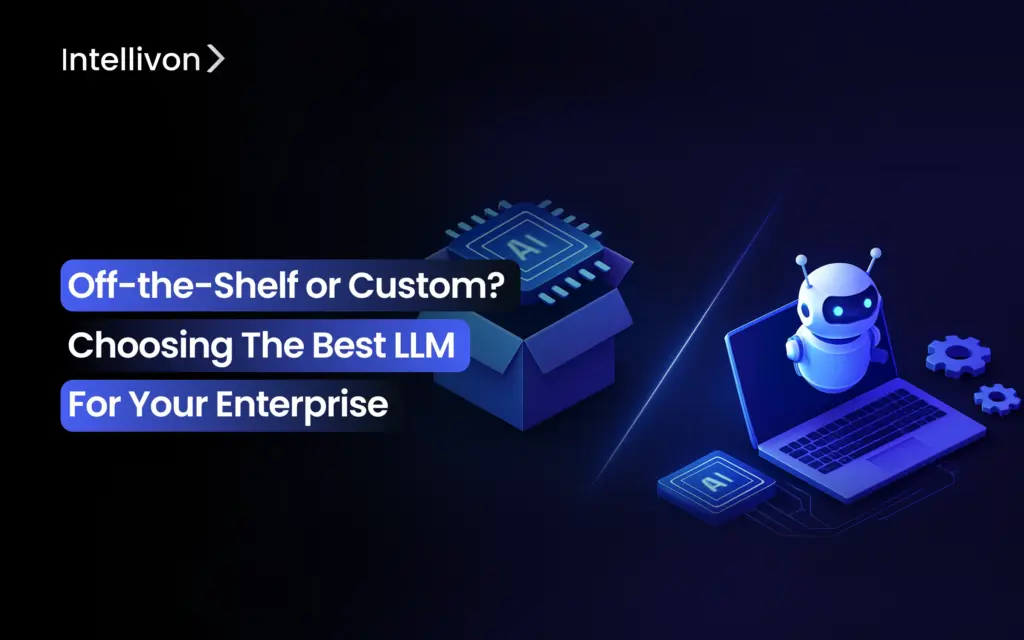
As AI continues to transform industries at an exponential pace, large enterprises are facing a critical decision: Should they opt for off-the-shelf LLMs or invest in custom-built solutions? The rapid growth of artificial intelligence offers companies the opportunity to streamline operations, enhance customer experiences, and unlock new insights. For instance, about 67% of organizations worldwide are using generative AI powered by LLMs to improve operations and processes across different industries. Off-the-shelf models, while offering speed and cost-effectiveness, often fall short when it comes to handling specific, industry-related challenges or ensuring the control and privacy of proprietary data. Custom LLMs, on the other hand, are built to meet the unique needs of each business, providing more flexibility and control but requiring a more considerable investment in time and resources. At Intellivon, we specialize in guiding enterprises through this decision-making process. Our hands-on expertise in custom LLM development empowers businesses to choose the best AI solution tailored to their long-term goals. With a focus on scalability, data privacy, and future-proofing, we help enterprises make data-driven decisions that support both immediate needs and future growth. In this blog, we will walk you through which LLM version you should pick for your enterprise needs and how we build and deploy custom LLMs from scratch. Understanding the Need For LLMs in Modern Enterprises According to a report by Research and Markets , the LLM market was valued at $5.72 billion in late 2024 and could grow to over $123 billion by 2034, with an annual growth rate of around 36%. LLMs are dominating almost every sphere of business operations and will continue to escalate in the coming years, which makes their adoption in large enterprises vital. Key Market Takeaways: About 67% of businesses worldwide are using large language models (LLMs) or generative AI to improve their operations. 72% of companies plan to increase their investment in LLMs this year, showing a strong commitment to the technology. Nearly 40% of companies are already spending over $250,000 annually on LLM adoption. By 2026, more than 80% of companies are expected to use generative AI or related APIs, a huge jump from just 5% in 2023. Over 70% of global businesses are using AI in at least one part of their operations, with generative AI playing a key role in areas like marketing, sales, IT, and customer service. Google’s LLMs are used by 69% of companies, while OpenAI’s models are used by 55%, according to recent surveys. The Role of LLMs in Enterprise AI As businesses adopt AI, LLMs are becoming essential tools for innovation and efficiency. These models can understand and generate human-like text, making them powerful for various enterprise functions. From automating customer support to analyzing data, LLMs help businesses improve processes and scale operations. As AI adoption grows, LLMs are becoming key to staying competitive. 1. Automating Customer Support LLMs are transforming customer support by automating responses and offering real-time assistance. AI-driven chatbots and virtual assistants can handle both simple and complex customer queries, reducing the workload on human agents. For example, Salesforce uses LLM-powered chatbots to manage customer interactions, speeding up response times and boosting customer satisfaction. 2. Enhancing Data Analysis and Insights LLMs can analyze massive amounts of unstructured data, such as reports and social media posts, to provide valuable insights. For example, a retail company can use LLMs to analyze customer feedback and identify emerging product trends. This helps businesses make quicker, more informed decisions and improves their data-driven strategies. 3. Scaling Operations Efficiently with LLMs LLMs help businesses scale by automating tasks that traditionally require human effort. For instance, large enterprises can use LLMs to automate data entry, organize documents, and manage internal communications. This leads to fewer errors and increased productivity, making it easier to scale operations without significantly raising costs. 4. LLMs in Predictive Analytics LLMs enhance decision-making by analyzing past data and providing predictions based on identified patterns. For example, financial institutions use LLMs for fraud detection, identifying suspicious activity by analyzing transaction trends. In healthcare, LLMs can predict patient outcomes, allowing providers to optimize treatment plans and improve care. Understanding Off-the-Shelf LLMs Off-the-shelf LLMs are pre-trained, general-purpose AI models like GPT, BERT, and Llama. These models are widely used because they are readily available and have been trained on massive amounts of data. They can generate human-like text, making them suitable for many basic tasks, such as chatbots, content generation, and customer support automation. Their popularity comes from their quick deployment and the ability to handle general use cases without needing specialized training. Advantages of Off-The-Shelf LLMs 1. Quick Deployment: Off-the-shelf LLMs are designed to be ready-to-use right out of the box. This means businesses can deploy them quickly with minimal setup time, allowing them to start benefiting from AI immediately. 2. Cost-Efficiency: Compared to building a custom model from scratch, using an off-the-shelf LLM is more affordable. These models offer a low-cost entry point for businesses experimenting with AI, without requiring a large upfront investment. 3. Proven Technology: Since these models have been used by countless organizations and tested in various scenarios, they are reliable for standard applications. Many well-documented resources and communities exist to help enterprises integrate and troubleshoot these tools. Limitations of Off-the-Shelf LLMs for Enterprises 1. Lack of Customization: While off-the-shelf models are powerful, they are general-purpose and not tailored to specific industries or business needs. For example, a legal firm using a general LLM might face challenges with context-specific language or regulations, leading to inaccurate responses. This can result in higher error rates and increased reliance on human oversight to correct mistakes. 2. Data Privacy and Security Concerns: Using third-party APIs for these models means sending sensitive, proprietary data to external providers. This can create significant security risks, especially if the provider doesn’t meet your organization’s privacy standards. For industries governed by strict regulations, such as finance (GDPR), healthcare (HIPAA), or consumer protection (CCPA), this can lead to non-compliance issues and expose your business to legal risks. 3. Scalability Issues: As
How to Build a Robust AI Governance Framework for Enterprises
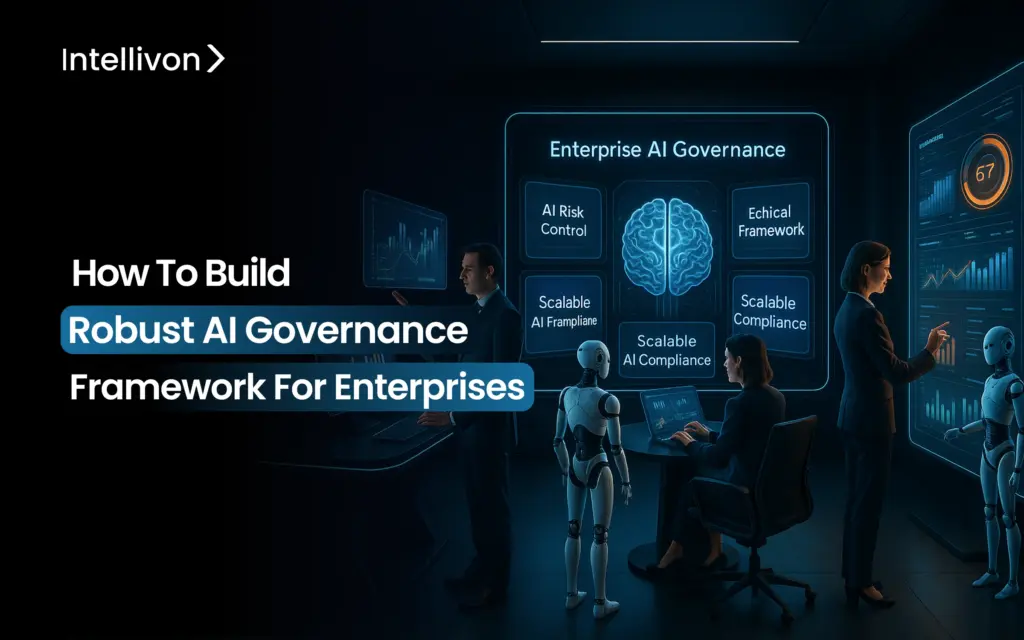
Enterprises today face growing pressure to ensure their AI systems are ethical, secure, and compliant with regulations. As AI becomes more integrated into every facet of enterprise operations, the risks associated with its unchecked deployment also rise. 89% of enterprises worry about AI security risks, but only 24% think their organizations have strong governance in place. Companies that fail to govern AI effectively can face serious consequences, including hefty fines, legal liabilities, and erosion of public confidence. That’s why building an AI governance framework that is scalable, transparent, and adaptable to future regulations is essential for any enterprise striving to stay competitive and compliant in the age of AI. At Intellivon, we specialize in building tailored AI governance frameworks that evolve with your AI maturity and regulatory requirements. Whether you’re just beginning to scale or managing complex AI initiatives, we provide solutions that help you navigate challenges while maintaining control. We’ve seen firsthand how the lack of proper governance can lead to delays, costly fines, or even a loss of customer trust. This guide will walk you through how we approach AI governance for our enterprise clients and how we can help build a scalable, compliant framework for your enterprise AI. What is AI Governance and Why Are Enterprises Adopting It? AI governance is a set of rules and systems that guide how companies use AI. It includes frameworks, policies, and oversight to make sure AI is used in a safe and responsible way. This means setting ethical standards, following laws, and managing risks. AI governance covers every stage of AI, from design to launch and beyond. It ensures that AI tools are trained, tested, used, and improved in line with company values and legal requirements. In short, robust AI governance helps organizations use AI to its full potential for necessary business operations while avoiding harm. Key Market Insights of AI Governance The global AI governance market is expected to grow rapidly, from $309 million in 2025 to about $4.83 billion by 2034, at a CAGR of 35.7%, according to Precedence Research. Large companies, mainly in finance, healthcare, and tech, make up about 70% of the market because they face more complex regulations. North America leads with 31% of the market in 2024, thanks to strong regulations and digital infrastructure. Big companies in finance, healthcare, and defense hold about 70% of the market. Market growth is driven by more global AI use and new regulations to manage risks like bias, privacy, and security. Why Enterprises Need AI Governance AI is changing how business operations work. More enterprises now use AI to solve big problems and create value. However, this rapid growth also brings serious challenges. That’s why strong AI governance is so important. 1. Ensures Regulatory Compliance New AI laws are appearing around the world, such as the EU AI Act. These rules can be complex and strict. With a solid AI governance framework, enterprises can follow new regulations, avoid fines, and protect their reputation. 2. Manages Risk AI systems can make mistakes or cause harm if not managed well. Without good oversight, they might introduce bias, privacy risks, or even security threats. AI governance sets clear rules to reduce these risks and protect everyone involved. 3. Promotes Accountability and Trust AI decisions can seem mysterious or hard to explain. This can lead to doubt or worry among customers, staff, and partners. Good governance ensures that AI is transparent and its decisions can be traced. This helps organizations explain how AI works and builds trust with stakeholders. 4. Enhances Data Security AI often relies on large amounts of sensitive data. Proper governance controls who can access this data and how it is used. As a result, businesses can protect their data and keep customer information safe. 5. Prevents Bias and Discrimination AI can sometimes learn unfair patterns from data. Governance frameworks require enterprises to check for bias, review data sources, and run audits. This helps make sure AI treats everyone fairly. 6. Drives Responsible Innovation Some people worry that rules slow down progress. However, AI governance actually helps enterprises move faster, with confidence. By setting clear standards, enterprises can adopt new AI tools safely, find new business opportunities, and avoid costly mistakes. 7. Strengthens Brand Reputation Enterprises that are open and ethical about their AI use earn more trust. Good governance shows customers, regulators, and partners that the business is serious about responsible AI. This can make a company stand out from its competitors. 8. Optimizes Operations and Lowers Costs Strong AI governance streamlines how companies manage AI projects. It makes audits and compliance easier, saving time and money. This means enterprises can scale their AI efforts and get more value from them in the long run. Our Core Pillars of Enterprise AI Governance Building a strong AI governance framework means starting with a solid foundation. When we build these frameworks for enterprises at Intellivon, we always focus on key pillars that form the base of our frameworks. These pillars make sure AI is used responsibly, earns trust, and supports growth. 1. Transparency Transparency is at the heart of effective AI governance. It means every decision made by an AI system should be clear and easy to explain. For example, if an enterprise uses AI to review job applications, the system’s choices need to be traceable. Stakeholders should be able to see why the AI picked one candidate over another. This openness builds trust and makes it possible to address concerns quickly. In addition, regular audits help companies find and fix mistakes, keeping the entire process honest and reliable. 2. Accountability Every AI project needs clear ownership. That’s why accountability is another essential pillar. We help enterprises define who is responsible for each part of the AI lifecycle. For instance, if an AI tool in a bank makes a decision about a loan, there should be someone who can answer questions and resolve issues. Setting up roles, responsibilities, and escalation paths ensures that problems are addressed quickly and
How to Build and Implement a Model Context Protocol (MCP) for Enterprise AI
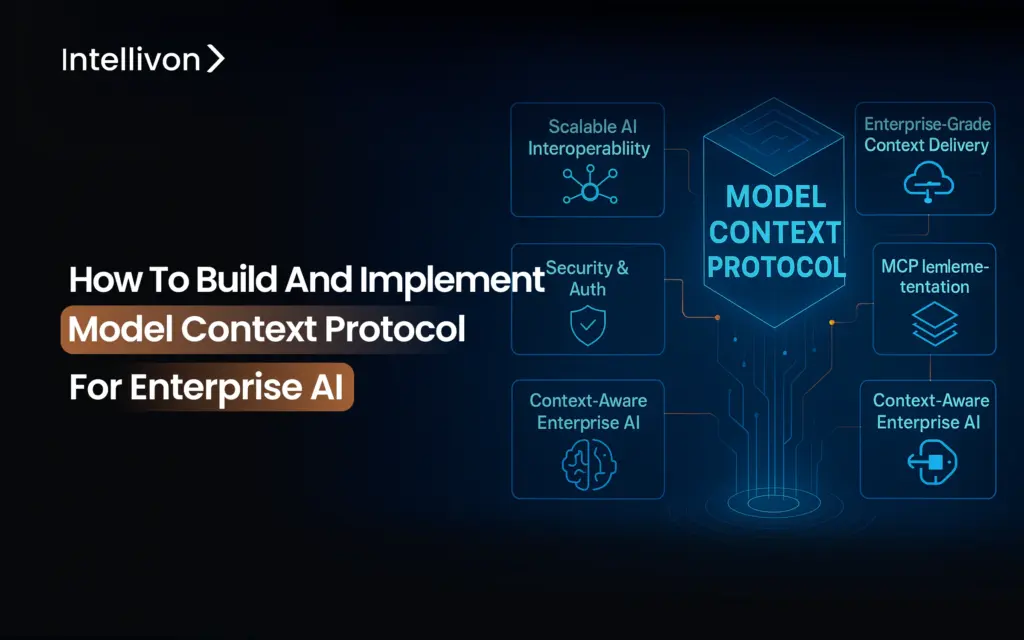
Generative AI has immense potential, but without access to enterprise CRM, ERP, or internal data systems, it’s just guessing its results. Many enterprises invest in powerful AI models, only to see them produce generic responses, hallucinate facts, or miss the mark entirely. The core issue? These models lack real-time, business-specific context. Without their AI being context-aware, enterprises report a 20-31% increase in hallucinations, leading to inconclusive results. This is where most enterprise AI initiatives break down. Even the most advanced LLMs fall short if they don’t understand your company’s goals, data landscape, or workflows. Without a structured way to feed them relevant, up-to-date context, AI becomes disconnected from your operations, reducing ROI, trust, and impact. Here is where Model Context Protocol (MCP), a strategic architecture that links AI models to your real business environment, comes in. It’s a foundational layer that ensures AI decisions are grounded in your systems, processes, and priorities and is context-aware. At Intellivon, we’ve helped leading enterprises build and deploy MCPs that turn AI from a disconnected novelty into a fully integrated business co-pilot. In this guide, you’ll learn exactly what an MCP is, why your AI needs one, and how we build and implement it step by step for enterprise AI. Understanding Model Context Protocol for Enterprise AI An MCP is an open framework designed for enterprise AI systems like LLMs or intelligent agents to securely and efficiently access and use relevant context from various external data sources and tools, all without needing separate custom integrations for each one. To understand this better, imagine your AI as a smart assistant sitting in your office. It’s sharp, fast, and well-trained. But when you ask it to pull up last quarter’s sales report, it just stares blankly. Why? Because it doesn’t know where to look or how to get it. With MCP, this problem is solved within minutes. The AI tells the MCP what it needs, like “Check the quarterly sales report.” The MCP then sends the right command to the correct tool, like your CRM or data warehouse, in a language that the system understands. Just like a remote doesn’t store content but knows how to access your TV, soundbar, and streaming box, the MCP doesn’t hold data. It knows how to route AI requests to the right business tools, instantly and intelligently. Key Components of an MCP An effective MCP is made up of several connected parts. Each plays a critical role in making your enterprise AI context-aware and action-ready. 1. AI Client This is your AI model or agent, like an LLM. It’s the brain behind the interaction, generating requests based on user input or tasks. 2. The MCP Server This is the translator and traffic controller. It listens to what the AI wants, understands the request, and sends it to the right tool in a format that the tool can process. It’s not an interface, but the bridge between thought and action. 3. Tools & Resources These are your internal systems, like databases, APIs, spreadsheets, ERP, CRM, knowledge bases, and more. MCP allows your AI to safely interact with these tools in a controlled and secure way. Key Takeaways of the MCP Market According to Fortune Business Insights, the Context-Aware Computing Market is projected to grow from USD 70.94 billion in 2025 to USD 122.20 billion by 2030, at a compound annual growth rate (CAGR) of 11.49%. The global MCP market is expected to reach $1.8 billion to $10.3 billion by 2025, growing at 34% annually due to rising demand for context-aware AI. Over 90% of organizations investing in AI are implementing or planning to implement MCP-enabled architectures, highlighting near-universal enterprise interest. Leading vendors like OpenAI, Microsoft, Anthropic, and SuperAGI are incorporating MCP standards into their products, validating its role in AI interoperability. MCP servers support large context windows (up to 10,000 tokens), high throughput (up to 1,000 requests per second), and innovations like federated learning and quantum-enhanced context. MCP is especially beneficial for data-heavy, compliance-driven industries like healthcare and finance, with notable use cases in customer support, enterprise automation, and IoT. Challenges Enterprises Face While Deploying AI Models Even with powerful models and major investments, many enterprises struggle to translate AI into real business value. Without a structured context layer, these challenges often go unresolved, thereby slowing down adoption, accuracy, and ROI. 1. Data Fragmentation and Siloes Enterprise data is usually spread across multiple platforms, like CRMs, ERPs, data lakes, and legacy systems. Since these systems rarely communicate well, AI ends up operating on partial, outdated information. This leads to weak predictions, missed insights, and stalled pilots that fail to scale due to inaccessible, siloed data. Data fed to AI systems is often inconsistent, unlabeled, or simply not fit for purpose. Without structure or accuracy, even advanced models generate hallucinations, confident but incorrect outputs. Over time, users lose trust in AI results, reducing adoption and value. 2. Lack of Legacy Integration Most enterprises depend on a mix of modern and legacy tools that don’t easily support integration. Connecting AI to each system often requires custom development, which is time-consuming and error-prone. These brittle connections slow down projects and make scaling difficult. 3. Organizational and Operational Resistance Even when AI systems are technically sound, they often face pushback from within. Employees may resist adoption due to a lack of training, skepticism, or simple unfamiliarity with how AI fits into their roles. Without clear communication and change management, usage drops and impact is limited. 4. Governance, Security, and Compliance Risks AI systems must align with strict internal and external compliance rules, covering privacy, security, ethics, and more. Meeting these standards can be complex and resource-intensive. Fear of breaches, fines, or ethical missteps often leads to overly cautious or piecemeal deployments. 8. Lack of Real-Time Context AI models often operate without access to the exact user, data, or workflow context needed at the moment of decision-making. This disconnect leads to responses that are generic, outdated, or just wrong. Without real-time context, even high-performing models
Build or Buy? Your Guide to Choosing an Enterprise AI Chatbot
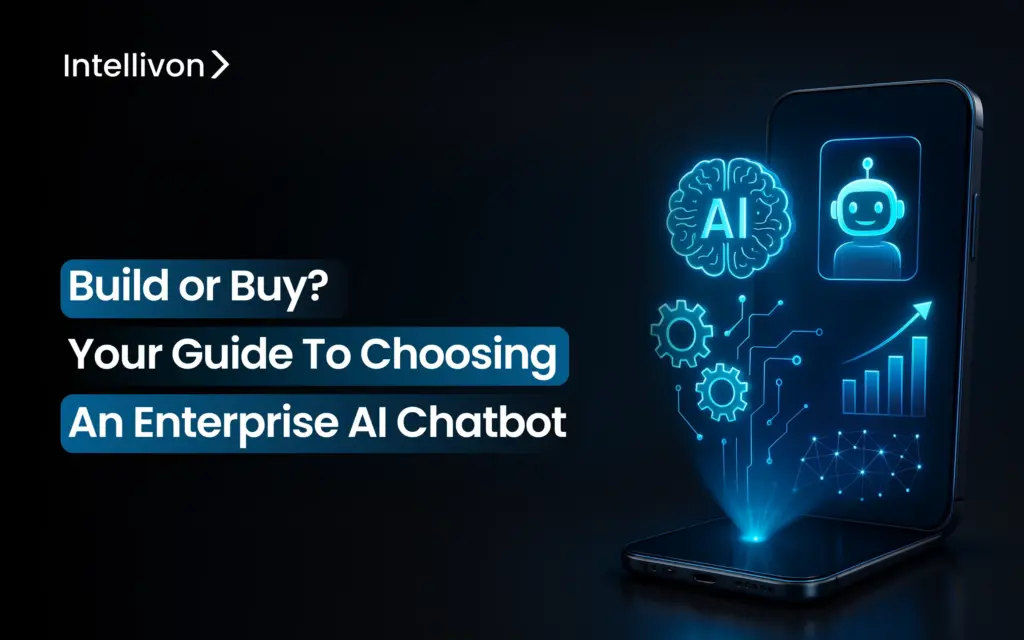
Many enterprise leaders are finding themselves caught in a maze of options when it comes to choosing the right AI chatbot. With so many solutions available, it’s easy to feel paralyzed by choice. The allure of “quick deployment” with off-the-shelf solutions is tempting. However, what often goes unnoticed is the long-term strategic value. The wrong choice can end up costing enterprises millions in lost opportunities due to inefficiencies and missed growth potential. For large enterprises, the stakes are high. A chatbot that doesn’t meet your specific needs can cause inefficiencies, missed opportunities, and a fragmented customer experience. While pre-built chatbots may seem like the fastest solution, they often lack the flexibility and scalability required for long-term success. On the other hand, custom-built chatbots provide a tailored experience designed to scale with your enterprise’s unique goals. Custom AI chatbots deliver 140% ROI in the first year alone compared to off-the-shelf solutions. Building a chatbot tailored to your enterprise not only provides a competitive advantage but also ensures you avoid the pitfalls of one-size-fits-all tools. At Intellivon, we’ve helped enterprises scale exponentially with our cutting-edge AI chatbots, powered to grow and adapt to large enterprise needs. In this blog, we will show you why custom-built chatbots are a better fit for your enterprise needs and how we develop them from the ground up. Comparison Between Buying and Building Enterprise AI Chatbots When it comes to selecting the right AI chatbot solution for your enterprise, the decision between building a custom chatbot or buying an off-the-shelf product is a critical one. Each option comes with its own set of advantages and challenges. To help you make an informed decision, we’ve broken down the key factors to consider, comparing the benefits of both approaches. 1. Budget and Cost Considerations One of the first things to consider when choosing between building or buying an enterprise AI chatbot is the cost. Buying an Off-the-Shelf Solution: Typically, purchasing an off-the-shelf chatbot comes with lower upfront costs. These solutions often have subscription pricing models, meaning you pay a recurring fee for access to the software. This model can be attractive to businesses with limited budgets, especially in the short term. Building a Custom Chatbot: On the other hand, building a custom chatbot requires a significantly higher initial investment. Developing a bespoke solution involves both a larger development budget and ongoing maintenance costs. However, the ROI for a tailored chatbot can be far greater in the long run, particularly when it aligns closely with business needs. While off-the-shelf chatbots are more affordable initially, custom-built chatbots provide greater value over time through tailored features and more control. 2. Time to Market Time is a crucial factor in today’s fast-paced business world. You may need to deploy an AI chatbot quickly to meet the growing demand of your customers. Buying an Off-the-Shelf Solution: If speed is a priority, buying a pre-built chatbot solution is your best bet. These solutions are ready to go, often deployable within days or weeks, meaning your business can start benefiting almost immediately. Building a Custom Chatbot: Building your own AI chatbot takes longer, typically several months. This extended timeline allows for deeper customization but delays the time it takes to see any real-world benefits. In the short term, buying a solution is faster, but building offers more long-term value through a chatbot that grows with your business. 3. Customization and Specific Business Needs Every enterprise is unique, and the ability to tailor an AI chatbot to your specific needs can be a deciding factor. Buying an Off-the-Shelf Solution: Pre-built solutions are often limited in terms of customization. While they may have essential features, they are generally not flexible enough to address complex, industry-specific requirements. Building a Custom Chatbot: One of the major advantages of building your own chatbot is the ability to customize it fully. A custom chatbot can be designed specifically for your business processes, ensuring seamless integration with existing systems and addressing unique challenges. If your business has specific requirements and needs a highly tailored solution, building is often the better option. 4. Scalability and Future Growth As your business grows, so too should your chatbot. It’s important to think about how well your chatbot can scale to meet increasing demands. Buying an Off-the-Shelf Solution: Many off-the-shelf chatbots come with limitations in scalability. While they work well for small to medium-sized enterprises, their performance may decline as your business expands, often requiring costly upgrades or additional features. Building a Custom Chatbot: Custom-built chatbots are designed with scalability in mind. You can ensure that the chatbot grows alongside your enterprise, evolving with your business needs and increasing customer expectations. In this case, building provides the flexibility and scalability that buying may lack. 5. Technical Expertise and Resources Building a chatbot from scratch is not a task to take lightly. It requires specialized expertise and resources. Buying an Off-the-Shelf Solution: Purchasing a ready-made chatbot solution typically involves minimal technical expertise. Your internal team does not need to worry about the intricacies of development, AI, or NLP. The vendor handles everything from deployment to maintenance. Building a Custom Chatbot: Developing a custom chatbot requires a dedicated team of developers, data scientists, and AI specialists. Additionally, ongoing maintenance and improvements fall to your internal team, which requires continuous technical expertise. If you can access external developers, building offers far more control and flexibility. Intellivon is a leading AI Chatbot developer, with our AI engineers and architects pre-vetted from renowned global institutions, who have transformed enterprises through robust AI chatbots. 6. Integration with Existing Systems Your chatbot must work seamlessly with your current systems, such as customer relationship management (CRM) tools, marketing platforms, and databases. Buying an Off-the-Shelf Solution: Off-the-shelf chatbots often come with limited integration capabilities. They may not integrate fully with your existing enterprise software, leading to a fragmented user experience and additional work to make the systems work together. Building a Custom Chatbot: A custom-built chatbot can be deeply integrated with your existing infrastructure. You
SaaS vs. Custom AI: Which is the Right Fit for Your Regulated Business
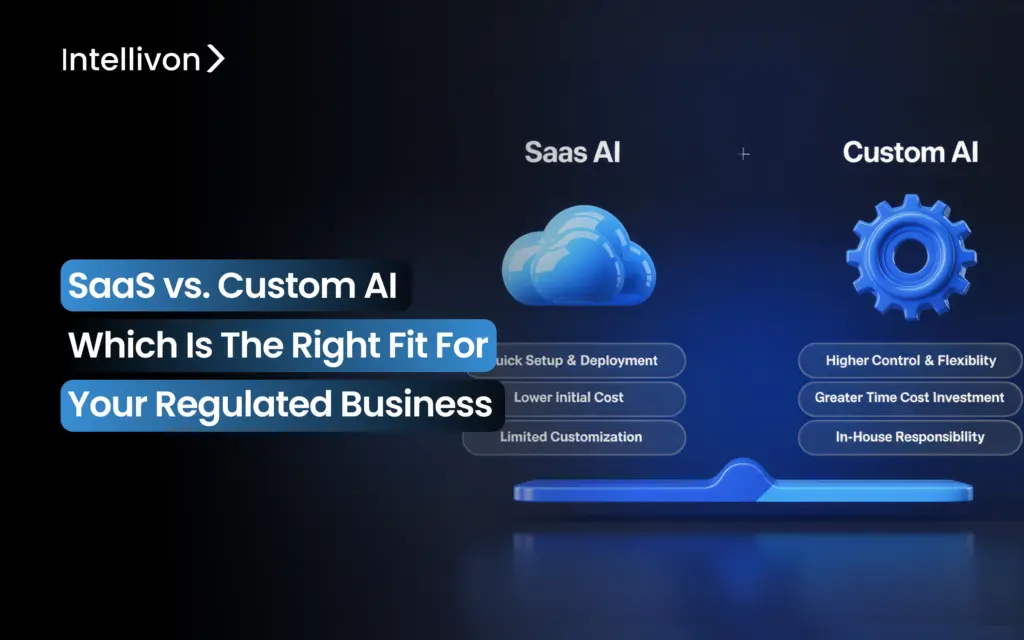
AI is transforming the regulated enterprise landscape with precision-based analytics, streamlined customer regulation support, and proper handling of proprietary data. 78% of regulated companies worldwide are already using AI in at least one part of their business. The use of generative AI has nearly doubled, rising from 33% in 2023 to 71% in 2024. However, enterprises in regulated industries still face a critical decision: Should they choose a Custom AI or a pre-built SaaS AI solution? Custom AI allows for tailored solutions that meet specific compliance and security requirements, while SaaS AI offers quicker deployment and lower upfront costs, but may not offer the same level of flexibility. Choosing the right solution depends on striking a balance between these trade-offs. According to Gartner (2024), companies that launch custom AI solutions see an average ROI of 55% over five years, compared to 42% for SaaS solutions in regulated and specialized industries. Organizations need AI tools that not only meet regulatory standards but also ensure data integrity and long-term reliability. At Intellivon, our expert AI experts have delivered tailored AI solutions for regulated industries with a strong focus on compliance and security. With years of hands-on experience, we’re here to guide you in selecting the right AI solution for your enterprise. In this blog, we’ll help you choose the best option and explain how we develop custom AI solutions from the ground up for regulated sectors. Understanding Regulated Industries and Why AI Compliance is Critical Navigating the regulatory landscape is about protecting your business from potentially devastating penalties and reputational damage. Here’s what’s at stake for enterprises in regulated sectors: GDPR (General Data Protection Regulation) Penalties: Fines up to €20 million or 4% of annual global turnover, whichever is higher. Even minor violations can trigger fines up to €10 million or 2% of global turnover. Key Facts: The largest fine to date is €1.2 billion, levied against Meta in 2023 for unlawful data practices. Consequence: Over €4.48 billion in fines have been issued in recent years, mostly for poor data handling. HIPAA (Health Insurance Portability and Accountability Act) Penalties: Fines range from $141 to $71,162 per violation. The annual maximum fine for repeated offenses is $1.5 million. Enforcement: The Office for Civil Rights enforces mandatory reporting and investigates almost every reported breach. Consequence: Even minor lapses in patient data protection can result in costly investigations and significant fines. FINRA (Financial Industry Regulatory Authority) & SOX (Sarbanes-Oxley Act) Penalties: Financial firms face large fines and legal action for compliance failures. Recent penalties include over $500,000 and a $12.5 million settlement for accounting violations. Consequence: Executives can face suspension, personal liability, or criminal prosecution for willful non-compliance. CCPA (California Consumer Privacy Act) Penalties: Fines of $2,500 per unintentional violation and $7,500 per intentional violation. Consumers can also receive damages between $100 and $750 per breach. Consequence: Non-compliance or delays in breach notifications can lead to rapid legal actions. The Cost of Non-Compliance Financial Impact: Studies show that non-compliance costs 2.7 times more than proactive compliance. This is due to escalating fines, productivity disruption, and expensive remediation efforts. Reputational Risk: High-profile breaches and record fines make headlines, leading to lost trust and customer attrition. The reputational damage often far outweighs the financial penalties. As regulations tighten and evolve, businesses must adopt solutions that are built to meet regulatory standards. Investing in tailored AI and data management systems not only strengthens compliance but also helps mitigate risks and provides operational confidence. Why AI Needs a Special Approach in Regulated Industries Unlike other sectors, regulated industries can’t simply adopt a generic AI solution and hope for the best. The AI solutions deployed must be designed with specific compliance requirements in mind. For regulated enterprises, the adoption of AI needs to focus on three non-negotiable pillars of compliance: 1. Data Sovereignty and Security In regulated industries, businesses must have full control over their data. This means knowing exactly where your data is stored, who can access it, and how it’s used. In a SaaS environment, businesses risk losing this control, which can be dangerous. Can a vendor use your data to train their own models? Can you be confident that your sensitive data is isolated from other customers in a multi-tenant environment? Losing control over your data is a risk that cannot be taken in these sectors. 2. Auditability and Explainability (XAI) Regulations like GDPR and laws governing the financial sector require that businesses be able to explain how AI makes decisions. If an AI denies a loan or flags a transaction for fraud, compliance officers need to trace the entire decision-making process. With black-box SaaS AI, this transparency is often unavailable. This lack of explainability can expose businesses to legal and regulatory risks. 3. Predictive Accuracy and Reliability In regulated industries, AI models can’t just be “mostly right.” For example, an AI used in healthcare must provide reliable diagnoses based on rigorously trained models to avoid critical errors. Similarly, AI models in finance must be precise to minimize false positives in fraud detection. Generic AI models trained on broad datasets are not reliable enough for these high-stakes environments. At Intellivon, we bake these three non-negotiable pillars of compliance into every layer of our AI solution. With this, we ensure your AI scales with your enterprise needs while keeping compliance, explainability, and accuracy intact. Custom AI vs. SaaS: Understanding the Key Differences When choosing an AI solution to implement for regulated industries, the decision often comes down to whether one should select a Custom AI or a SaaS AI solution. Both options have their benefits and drawbacks, but for businesses operating in regulated sectors, the stakes are high. Compliance, security, and reliability are non-negotiable factors in selecting the right solution. Let’s explore the pros and cons of both Custom AI and SaaS AI to help you make an informed decision. Pros of Custom AI Solutions 1. Full Compliance Control Custom AI can be designed specifically to meet the unique compliance needs of regulated industries. From HIPAA in
